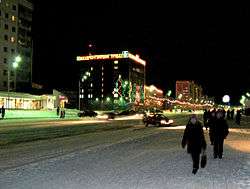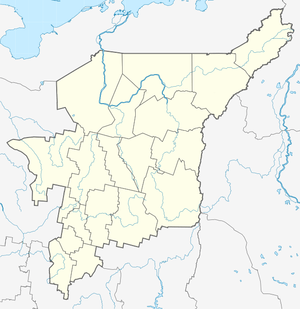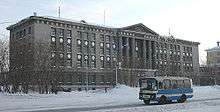Vorkuta
| Vorkuta (English) Воркута (Russian) Вӧркута (Komi) | |
|---|---|
| - Town[1] - | |
 Central Vorkuta | |
.svg.png) Location of the Komi Republic in Russia | |
 Vorkuta | |
|
| |
 |
|
|
| |
| Administrative status (as of October 2011) | |
| Country | Russia |
| Federal subject | Komi Republic[1] |
| Administratively subordinated to | town of republic significance of Vorkuta[1] |
| Administrative center of | town of republic significance of Vorkuta[1] |
| Municipal status (as of October 2011) | |
| Urban okrug | Vorkuta Urban Okrug[2] |
| Administrative center of | Vorkuta Urban Okrug[2] |
| Administration Manager[3] | Igor Gurlev[3] |
| Statistics | |
| Population (2010 Census) | 70,548 inhabitants[4] |
| - Rank in 2010 | 224th |
| Time zone | MSK (UTC+03:00)[5] |
| Founded | January 4, 1936[6] |
| Town status since | November 26, 1943[6] |
| Postal code(s)[7] | 169900 |
| Dialing code(s) | +7 82151 |
|
| |
| Vorkuta on Wikimedia Commons | |
Vorkuta (Russian: Воркута́; Komi: Вӧркута, Vörkuta; Nenets for place teems with bears)[8] is a coal-mining town in the Komi Republic, Russia, situated just north of the Arctic Circle in the Pechora coal basin at the Usa River. Population: 70,548 (2010 Census);[4] 84,917 (2002 Census);[9] 115,646 (1989 Census).[10]
History
Industrial coal fields by Vorkuta River were discovered in 1930 by geologist Georgy Chernov. Georgy was the son of another geologist, Alexander Chernov, who promoted the development of the Pechora coal basin, which included the Vorkuta fields.[11][12] With this discovery the coal mining industry started in Komi ASSR. At the time only the southern parts of the field were included in the Komi ASSR. The northern part, including Vorkuta, belonged to Nenets Autonomous Okrug of Arkhangelsk Oblast. In 1931 a geologist settlement was established by the coal field, with most of the workers being inmates of the Ukhta-Pechora Camp of GULAG (Ухтпечлаг, Ukhpechlag). [11][13] The origins of the town of Vorkuta are associated with one of the more notorious forced labour camps of the Gulag which was established in 1932, with the start of mining.
In 1941, Vorkuta and the labor camp system based around it were connected to the rest of the world by a prisoner-built rail line linking Konosha, Kotlas, and the camps of Inta. Town status was granted to Vorkuta on November 26, 1943.[11] It was the largest of the Gulag camps in European Russia and served as the administrative center for a large number of smaller camps and subcamps, among them Kotlas, Pechora, and Izhma (modern Sosnogorsk). In 1953, the town witnessed a major uprising by the camp inmates.
Administrative and municipal status
Within the framework of administrative divisions, it is, together with eight urban-type settlements (Komsomolsky, Mulda, Oktyabrsky, Promyshlenny, Severny, Vorgashor, Yeletsky, and Zapolyarny) and seven rural localities, incorporated as the town of republic significance of Vorkuta—an administrative unit with the status equal to that of the districts.[1] As a municipal division, the town of republic significance of Vorkuta is incorporated as Vorkuta Urban Okrug.[2]
Economy
By the early 21st century many mines had closed as problems with the high costs of operation plagued the mine operators. At one time during the late 1980s and 1990s there were labor actions in the area by miners who had not been paid for a year.[14][15]
Climate

Vorkuta has a subarctic climate with short cool summers and very cold and dry winters. The average February temperature is about −20 °C (−4 °F), and in July it is about +13 °C (55 °F).
| Climate data for Vorkuta | |||||||||||||
|---|---|---|---|---|---|---|---|---|---|---|---|---|---|
| Month | Jan | Feb | Mar | Apr | May | Jun | Jul | Aug | Sep | Oct | Nov | Dec | Year |
| Record high °C (°F) | 1.1 (34) |
1.2 (34.2) |
5.3 (41.5) |
12.0 (53.6) |
26.5 (79.7) |
31.0 (87.8) |
33.8 (92.8) |
30.0 (86) |
24.2 (75.6) |
15.6 (60.1) |
4.8 (40.6) |
3.5 (38.3) |
33.8 (92.8) |
| Average high °C (°F) | −15.6 (3.9) |
−16.1 (3) |
−9.6 (14.7) |
−5.5 (22.1) |
1.7 (35.1) |
12.7 (54.9) |
18.7 (65.7) |
14.2 (57.6) |
7.8 (46) |
−0.8 (30.6) |
−9.5 (14.9) |
−13.9 (7) |
−1.3 (29.7) |
| Daily mean °C (°F) | −19.5 (−3.1) |
−20.0 (−4) |
−13.9 (7) |
−10.0 (14) |
−1.9 (28.6) |
7.6 (45.7) |
13.2 (55.8) |
9.7 (49.5) |
4.3 (39.7) |
−3.4 (25.9) |
−13.3 (8.1) |
−17.6 (0.3) |
−5.4 (22.3) |
| Average low °C (°F) | −23.6 (−10.5) |
−23.9 (−11) |
−18.1 (−0.6) |
−14.4 (6.1) |
−5.2 (22.6) |
3.3 (37.9) |
8.2 (46.8) |
5.8 (42.4) |
1.3 (34.3) |
−6.1 (21) |
−16.5 (2.3) |
−21.6 (−6.9) |
−9.2 (15.4) |
| Record low °C (°F) | −48.0 (−54.4) |
−49.4 (−56.9) |
−41.0 (−41.8) |
−38.5 (−37.3) |
−26.3 (−15.3) |
−8.4 (16.9) |
−1.0 (30.2) |
−4.0 (24.8) |
−10.5 (13.1) |
−29.0 (−20.2) |
−45.1 (−49.2) |
−52.0 (−61.6) |
−52.0 (−61.6) |
| Average precipitation mm (inches) | 36 (1.42) |
34 (1.34) |
33 (1.3) |
27 (1.06) |
35 (1.38) |
52 (2.05) |
55 (2.17) |
63 (2.48) |
57 (2.24) |
57 (2.24) |
40 (1.57) |
42 (1.65) |
531 (20.91) |
| Average snowfall cm (inches) | 42 (16.5) |
59 (23.2) |
77 (30.3) |
81 (31.9) |
60 (23.6) |
19 (7.5) |
0 (0) |
0 (0) |
3 (1.2) |
10 (3.9) |
20 (7.9) |
26 (10.2) |
397 (156.2) |
| Average rainy days | 1 | 0 | 1 | 3 | 9 | 16 | 19 | 22 | 19 | 10 | 2 | 1 | 103 |
| Average snowy days | 25 | 21 | 23 | 19 | 16 | 4 | 0 | 0 | 4 | 18 | 24 | 26 | 180 |
| Average relative humidity (%) | 81 | 80 | 81 | 79 | 79 | 72 | 74 | 82 | 85 | 88 | 84 | 82 | 80.6 |
| Source: Pogoda.ru.net[16] | |||||||||||||
Miscellaneous
The town is served by Vorkuta Airport. During the Cold War, an Arctic Control Group forward staging base for strategic bombers was located at Vorkuta Sovetsky.[17]
One of the largest coal mine disasters in Russia occurred at Vorkuta coal mine on 28 February 2016, when leaking methane gas ignited and killed 32 people, including 26 trapped miners who had been stranded by a similar explosion 3 days prior that had killed four miners.[18]
References
Notes
- 1 2 3 4 5 Law #16-RZ
- 1 2 3 Law #11-RZ
- 1 2 Глава городского округа (in Russian). May 2013. Retrieved May 23, 2013.
- 1 2 Russian Federal State Statistics Service (2011). "Всероссийская перепись населения 2010 года. Том 1" [2010 All-Russian Population Census, vol. 1]. Всероссийская перепись населения 2010 года (2010 All-Russia Population Census) (in Russian). Federal State Statistics Service. Retrieved June 29, 2012.
- ↑ Правительство Российской Федерации. Федеральный закон №107-ФЗ от 3 июня 2011 г. «Об исчислении времени», в ред. Федерального закона №271-ФЗ от 03 июля 2016 г. «О внесении изменений в Федеральный закон "Об исчислении времени"». Вступил в силу по истечении шестидесяти дней после дня официального опубликования (6 августа 2011 г.). Опубликован: "Российская газета", №120, 6 июня 2011 г. (Government of the Russian Federation. Federal Law #107-FZ of June 31, 2011 On Calculating Time, as amended by the Federal Law #271-FZ of July 03, 2016 On Amending Federal Law "On Calculating Time". Effective as of after sixty days following the day of the official publication.).
- 1 2 Информационный портал администрации Воркуты - История Воркуты 1930-1945 годы (in Russian). Archived from the original on October 8, 2011. Retrieved March 14, 2011.
- ↑ Почта России. Информационно-вычислительный центр ОАСУ РПО. (Russian Post). Поиск объектов почтовой связи (Postal Objects Search) (Russian)
- ↑ "About city". Retrieved 11 February 2016.
- ↑ Russian Federal State Statistics Service (May 21, 2004). "Численность населения России, субъектов Российской Федерации в составе федеральных округов, районов, городских поселений, сельских населённых пунктов – районных центров и сельских населённых пунктов с населением 3 тысячи и более человек" [Population of Russia, Its Federal Districts, Federal Subjects, Districts, Urban Localities, Rural Localities—Administrative Centers, and Rural Localities with Population of Over 3,000] (XLS). Всероссийская перепись населения 2002 года [All-Russia Population Census of 2002] (in Russian). Retrieved August 9, 2014.
- ↑ Demoscope Weekly (1989). "Всесоюзная перепись населения 1989 г. Численность наличного населения союзных и автономных республик, автономных областей и округов, краёв, областей, районов, городских поселений и сёл-райцентров" [All Union Population Census of 1989: Present Population of Union and Autonomous Republics, Autonomous Oblasts and Okrugs, Krais, Oblasts, Districts, Urban Settlements, and Villages Serving as District Administrative Centers]. Всесоюзная перепись населения 1989 года [All-Union Population Census of 1989] (in Russian). Институт демографии Национального исследовательского университета: Высшая школа экономики [Institute of Demography at the National Research University: Higher School of Economics]. Retrieved August 9, 2014.
- 1 2 3 "История Воркуты"(Russian)(retrieved August 3, 2004)
- ↑ "История Воркуты"(Russian)(retrieved August 3, 2004)
- ↑ "Историческая справка. МО ГО "Воркута""(Russian) (retrieved August 3, 2004)
- ↑ "Vorkuta Miners Hold Authorities Prisoners". Russia Today. www.aha.ru. Retrieved 2008-07-18.
- ↑ Keller, Bill (1990-08-27). "At Gulag Cemetery, a Struggle Against Forgetting". The New York Times. ISSN 0362-4331. Retrieved 2015-10-15.
- ↑ "Pogoda.ru.net" (in Russian). Retrieved February 16, 2012.
- ↑ "Vorkuta". www.globalsecurity.org. Retrieved 2008-07-18.
- ↑ "Russian Coal Mine Accident in Vorkuta Kills 36, Including 5 Rescuers". Associated Press. 28 February 2016. Retrieved 28 February 2016.
Sources
- Государственный Совет Республики Коми. Закон №13-РЗ от 6 марта 2006 г. «Об административно-территориальном устройстве Республики Коми», в ред. Закона №171-РЗ от 26 декабря 2014 г. «Об упразднении населённого пункта Верхняя Седка, расположенного на территории Прилузского района Республики Коми, и внесении в связи с этим изменений в некоторые Законы Республики Коми». Вступил в силу со дня официального опубликования. Опубликован: "Республика", №44, 16 марта 2006 г. (State Council of the Komi Republic. Law #16-RZ of March 6, 2006 On the Administrative-Territorial Structure of the Komi Republic, as amended by the Law #171-RZ of December 26, 2014 On Abolishing the Inhabited Locality of Verkhnyaya Sedka Located on the Territory of Priluzsky District of the Komi Republic, and on Amending Various Laws of the Komi Republic Accordingly. Effective as of the official publication date.).
- Государственный Совет Республики Коми. Закон №11-РЗ от 5 марта 2005 г. «О территориальной организации местного самоуправления в Республике Коми», в ред. Закона №171-РЗ от 26 декабря 2014 г. «Об упразднении населённого пункта Верхняя Седка, расположенного на территории Прилузского района Республики Коми, и внесении в связи с этим изменений в некоторые Законы Республики Коми». Вступил в силу 1 апреля 2005 г.. Опубликован: "Республика", №44–45, 17 марта 2005 г. (State Council of the Komi Republic. Law #11-RZ of March 5, 2005 On the Territorial Organization of the Local Self-Government in the Komi Republic, as amended by the Law #171-RZ of December 26, 2014 On Abolishing the Inhabited Locality of Verkhnyaya Sedka Located on the Territory of Priluzsky District of the Komi Republic, and on Amending Various Laws of the Komi Republic Accordingly. Effective as of April 1, 2005.).
- Adapted from the article Vorkuta, from Wikinfo, licensed under the GNU Free Documentation License.
External links
- The official website of Vorkuta (Russian)
- Vorcutincy.ru - The site of Vorkuta (Russian)
- Vorkutlag-Vorkuta. Double remembrance to the Soviet history of the city.
- Vorkuta. History (Russian)
- First webcam Vorkuta overlooking the main street of the city (Russian)
- Contemporary photographs of Vorkuta
- Historical photographs
- Other photographs